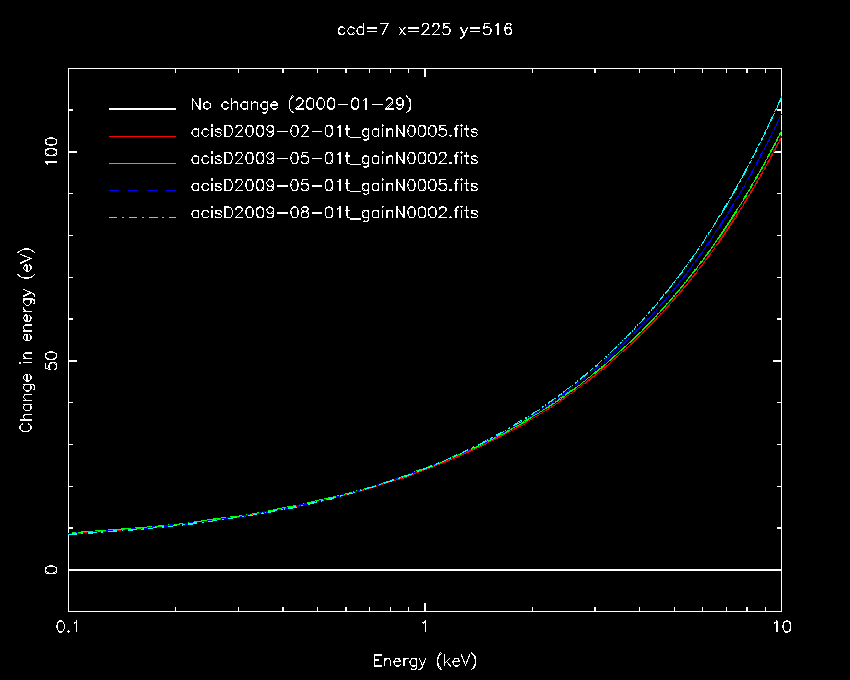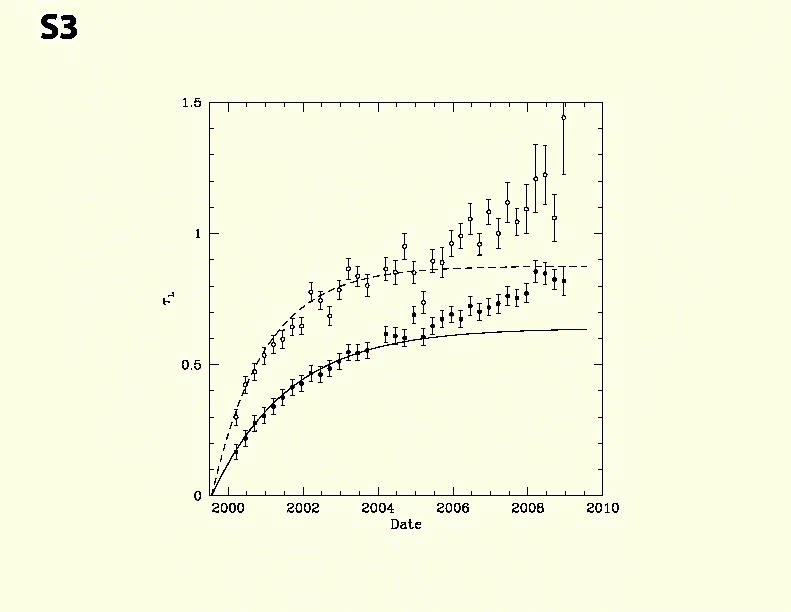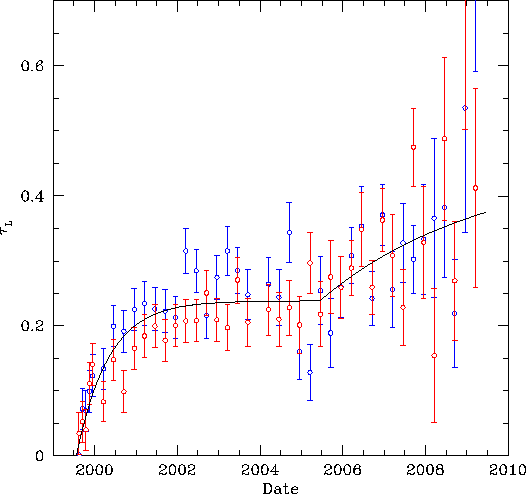
Fig.
1: Comparison of the total change in eV due to the Epoch 37, 38, and
39 T_GAIN files, for the I3 aimpoint.
<Return to CalDB Release Notes>
CalDB PUBLIC Release Notes
Effective Date: (UTC) 2010-01-08T20:41:50
SDP Installation Date: 2010-01-08T20:41:50
Version: 4.1.5
Release Type: SDP ONLY
CaldB 4.1.5 is a patch upgrade to CalDB version 4.1.4 for Standard data processing only. It includes the following upgrades:
ACIS T_GAIN Epoch 39 (01 August through 31 October 2009)
ACIS CONTAM version 5: Improvement in ACIS OBF contamination modeling for observations taken since 2005.
PIMMS CYCLE 12 effective area upgrades, for internal CXC proposal planning builds only. NOTE: Users never access these file directly, nor should they use them for any analytical purpose.
CalDB 4.1.5 is a patch release to CalDB 4.1.4, which does NOT include the HRC-I SAMP-based GMAPs and HRC-S T_GMAP file, or other associated upgrades. It also does not include any upgrades or corrections to the HRC-I RMF file, and so should not be used for CIAO 4.2 reprocessing or HRC-I quatile color-color analysis.
LOCATION:
$CALDB/data/chandra/acis/t_gain/
CODENAME: T_GAIN
FILENAMES:
acisD2009-05-01t_gainN0005.fits
acisD2009-05-01t_gainN0006.fits
acisD2009-08-01t_gainN0002.fits
acisD2009-08-01t_gain_biN0002.fits
The Epoch 39 (Aug - Sep 2009) have now been released as indicated above;
hence the Epoch 38 interpolations (the 2009-05-01 filenames above,
applicable for observation dates May through July 2009) are now
finalized. The previous epoch N0002 files have been demoted to "BAD"
status, though they are still in the circulation with the CalDB, just
in case they are needed for comparison to earlier analyses. See the
Tech Details below for information on the degree of effect versus
energy that the new corrections will have on your particular ACIS
datasets. These new files will only affect data with DATE-OBS after
2009-05-01T00:00:00. All earlier data are unaffected by this
change.
Users analyzing observations with DATE_OBS later than
2009-05-01 are encouraged to reprocess their Level 1 events data
through Level 2, to verify whether or not their previous analysis
results are at all affected by these new data. The plots in Tech
Details section III.A give some a priory indications of how
these data will affect them.
Pipes/Tools affected:
SDP/CIAO tool acis_process_events
Threads affected:
Any thread that employs acis_process_events with the
parameter apply_tgain set
to "yes", which is the default state.
Specifically,
"Reprocessing to create a new (ACIS) L2 events
file"
http://cxc.harvard.edu/ciao/threads/createL2/index.html#acis
BRANCH:
$CALDB/data/chandra/acis/contam/
CODENAME:
CONTAM
FILENAMES: acisD1999-08-13contamN0005.fits
A new model for the ACIS time-dependent QE degradation is now available. This is modeled as a time-variable carbon-oxygen-fluorine + extra component contaminant on the ACIS optical blocking filters, and hence the CalDB file is designated "CONTAM". The new file includes separately derived models for ACIS-I from ACIS-S, because the behavior versus time for I3 is different than for S3, near both the aimpoints and the edges. The old file, N0004, was about to expire as of the end of 2009, and its applicability beyond that time is problematic. The new file replaces the old one for all mission times.
Pipes/Tools affected:
CIAO tools mkarf, mkgarf (fullgarf), mkinstmap (mkexpmap)
Threads affected:
ACIS imaging (exposure maps):
Multiple Chip ACIS Exposure Map:
http://cxc.harvard.edu/ciao/threads/expmap_acis_multi/
ACIS imaging spectroscopy (ARFs):
specextract:
http://cxc.harvard.edu/ciao/threads/specextract/
psextract:
http://cxc.harvard.edu/ciao/threads/psextract/
Step by step:
http://cxc.harvard.edu/ciao/threads/streakextract/index.html#arf
http://cxc.harvard.edu/ciao/threads/wresp_multiple_sources/index.html#warf
http://cxc.harvard.edu/ciao/threads/pieces/index.html#arf
ACIS Grating Spectroscopy (using fullgarf):
http://cxc.harvard.edu/ciao/threads/mkgarf_hetgacis/
http://cxc.harvard.edu/ciao/threads/mkgarf_letgacis/
BRANCH: $CALDB/data/chandra/pimms/
CODENAME: PIMMS_EA
ACIS configurations:
ACIS-I aimpoint: acisiD2009-11-05pimmsN0012.fits
ACIS-I/HETG0: acisihetg0D2009-11-05pimmsN0012.fits
ACIS-I/LETG0: acisiletg0D2009-11-05pimmsN0012.fits
ACIS-S aimpoint: acissD2009-11-05pimmsN0012.fits
ACIS-S/HETG0: acisshetg0D2009-11-05pimmsN0012.fits
ACIS-S/HEG1: acissheg1D2009-11-05pimmsN0012.fits
ACIS-S/MEG1: acissmeg1D2009-11-05pimmsN0012.fits
ACIS-S/HEGMEG1: acisshegmeg1D2009-11-05pimmsN0012.fits
ACIS-S/LETG0: acissletg0D2009-11-06pimmsN0012.fits
ACIS-S/LEG1: acissleg1D2009-11-06pimmsN0012.fits
HRC configurations:
HRC-I aimpoint: hrciD2009-11-05pimmsN0012.fits
HRC-I/LETG0: hrciletg0D2009-11-05pimmsN0012.fits
HRC-S aimpoint: hrcsD2009-11-16pimmsN0012.fits
HRC-S/LETG0: hrcsletg0D2009-11-16pimmsN0012.fits
HRC-S/LEG1: hrcsleg1D2009-11-16pimmsN0012.fits
HRC-S/LETG HIGHER ORDER: hrcsleghiD2009-11-16pimmsN0012.fits
NOTE: These files are not used in software directly from CalDB, and instead are here to maintain them as part of the CalDB release; they are built from other concurrently-indexed CalDB files, and are managed by the CalDB manager. Users have no need of these files, and should not use them for analysis.
For plots of the above effective
areas, see the PIMMS effective areas CalDB page at:
http://cxc.harvard.edu/caldb4/prop_plan/pimms/index.html
or the PIMMS effective area viewer at:
http://cxc.harvard.edu/cgi-bin/build_viewer.cgi?ea
The total corrections versus photon energy for epochs 37, 38, and 39 files, in eV, are given in the figures below, for the ACIS-I and ACIS-S aimpoint positions specifically. We note here that corrections a various points across the chip surface may be rather different, even very significantly so, from these results.
The three figures below give the T_GAIN correction values in eV, as a function of photon energy, for aimpoint positions on chip I3 (Fig. 1), and for S3 with CTI correction applied (Fig. 2), and for S3 without the CTI correction (Fig. 3). The red curve is for Epoch 37, and interpolates between the epoch 37 and 38 corrections at the mid-point in time (average of the T_GAIN values). The 2009-05-01 files are for Epoch 38. The t_gainN0006.fits file replaces the t_gain_biN0002.fits file. The acisD2009-08-01t_gain_biN0002.fits file is a flat, non-interpolating file, and will be upgraded after Epoch 40 has been completed (Nov 1, 2009 - Jan 31, 2010).
As seen in Fig. 1, the Epoch 39 corrections are more significant in I3 than in the previous two epochs. Users should be careful to check their I3 results for observations taken after May 2009, so verify that this set up upgrades does not affect their results for I3 observations. As is usually the case, the modifications vary from epoch to epoch, and future additions may trend in the opposite direction. Other locations on chip S3 may show a different degree of T_GAIN shift.

Fig.
1: Comparison of the total change in eV due to the Epoch 37, 38, and
39 T_GAIN files, for the I3 aimpoint.
Figures 2 and 3 indicate that the upgrades for epoch 39 for chip S3 aimpoint are not as significant as for the I3 aimpoint above. However, these results may be modified by Epoch 40 upgrades as well, when they are available.

Fig
2: A similar plot for the aimpoint of the BI chips S3, with the CTI
corrections applied to the data. For this location and chip, the
recent T_GAIN upgrades show only small corrections, and the trend
continues with Epoch 39. This result may be modified by the next
epoch data as well.

Fig.
3: The S3 aimpoint corrections for the case where the BI chips are
NOT CTI-corrected at all. (The N0005 files.)
At this point in time, an upgrade to the N0004 CONTAM file was necessary, as it was provided as a 10-year correction model, to be updated by the end of calendar year 2009 in any case. However, since 2006, the N0004 model has become increasingly less satisfactory for ACIS-S in particular as shown in Fig. 4 below:

Fig.
4: The optical depth of the contaminant as measured
with the ECS on ACIS-S3 for the aimpoint (solid points) and the edge
of the chip (open symbols). The curves give the corresponding
predictions for the contaminant using the N0004 CONTAM file.
The new ACIS CONTAM file includes separate model corrections for ACIS-S and ACIS-I, which deal with the differing trends versus time for the contaminants on the two separate optical blocking filters (OBF).
ACIS-I Model upgrade:
The ACIS-I model components are the
same as with the N0004 model, specifically a series of elements, H,
C, O, and F, contributing some of the optical depth and the edge
structure in the contaminant, and an additional edge-less component
"fluffium" that adds optical depth to the elemental model
in order to fit the measured results from the ACIS external
calibration source (ECS). In the new version, separate analytic
functions are used to model the time dependence of the elemental and
the two-level (fluffium) components. The scalings of the C:O and C:F
ratios were determined from gratings data with LETG/ACIS-S. The
elemental ratios are now C:F=20, and C:O=12.5. However, the fluffium
component was scaled according to the ECS data from ACIS-I.
The fits to the measured optical depth at 660 eV (from the ECS Mn-L and F-K lines) are given in Fig. 5 below. Here, the scaled elemental model is shown as the dashed curves, and the scaled elemental plus 2-level (fluffium) as the solid curves.

Fig. 5: ECS (660 eV) measured optical depth on ACIS-I at the aimpoint and
at the edge (symbols), with the scaled elemental model (dashes) and
the scaled elemental plus fluffium model (solid curve).
ACIS-S Model upgrade:
For ACIS-S, there are two major changes in the contamination model version N0005:
The time-dependence has been adjusted to account for the accelerated contamination build-up that is shown in Fig. 4 above. Improved gain corrections for the BI chips now available for data taken in late 1999 at ACIS FP_TEMP=-110C have allowed more accurate measurement of the contamination build-up early in the mission. Extrapolation of the ECS optical depths taken throughout the mission results in an optical depth of 0.1 at launch--not very likely physically, but marginally consistent with the uncertainties in the ECS measurements at launch. This offset has been assumed into the time-dependence model for ACIS-S.

Fig. 6: The time-dependence used for the ACIS-S portion of the N0005
contamination model file, over the course of the mission. The solid
black curve is the time-dependence model used in CONTAM version
N0005 for ACIS-S chips.

Fig. 7: The early-time buildup of the contaminant measured by the ECS
(black dots) and ACIS-S observations of clusters of galaxies early
in the mission (blue data points). The dashed curve gives the best
fit with a free (not fixed at zero) offset for the optical depth at
launch. The solid curve, with the 0.1 optical depth offset
subtracted, was used for the time-dependence for ACIS-S in the N0005
CONTAM file.
A new empirical determination of the extra absorption component has been employed, taking the ratio of spectra from 1999 and 2009 observations of the Coma Cluster. After taking into account the elemental absorption derived from gratings data, the ratio of the Coma spectra shows an addtional component whose optical depth gradually increases toward lower energies. This extra component can be fit by a Gaussian centered at E=0 and sigma = 600 eV.
The ratio in the absorption in the individual elements C, O, and F, versus the addtional component has been redetermined using LETG/ACIS-S spectra of AGNs. The results indicate that, within the uncertainties, the spectrum of the addtional absorption component has not changed over the past 10 years, and so can be normalized at any point in time and location on ACIS-S using the ECS measurements.
The spatial variation in the depth of the ACIS-S contaminant has been updated according to the solid line in the figure below. The illustration shows the differences between the ECS optical depths at the top and bottom of ACIS-S3 and those in the center of S3. The line gives the analytic function best fit to those data points. The variation in the depth is taken to be symmetrical about the center of ACIS-S, going up or down on the chips.
 Fig. 8: The differences (delta-tau) between ECS optical depths at the top
(red) and bottom (blue) of ACIS-S and the center of ACIS-S. The
solid curve is the model used for the spatial variation of the
ACIS-S contaminant in version N0005.
Fig. 8: The differences (delta-tau) between ECS optical depths at the top
(red) and bottom (blue) of ACIS-S and the center of ACIS-S. The
solid curve is the model used for the spatial variation of the
ACIS-S contaminant in version N0005.
Behavior of the new file with time:
Plots of the time progression of the contaminant for several dates for the respective
aimpoints of ACIS-I and ACIS-S are shown below.
|
TIME factor (UTC) |
Curve color |
|
CONTAM OFF |
Black |
|
2000-05-15T00:00:00 |
Red |
|
2001-05-15T00:00:00 |
Green |
|
2011-05-01T00:00:00 |
Blue |

Fig. 9: Variation in the ACIS-I effective area for the times given in the
table above, using the N0004 contam model (dashes) and the N0005
model (solid curves).
 Fig. 10: Variation in the ACIS-S effective area for the times given in
the table above, using the N0004 contam model (dashes) and the
N0005 model (solid curves).
Fig. 10: Variation in the ACIS-S effective area for the times given in
the table above, using the N0004 contam model (dashes) and the
N0005 model (solid curves).
Further details regarding the derivation and testing of the N0005 CONTAM upgrade are available in the memorandum "Update to the ACIS Contamination Model," available from the Instruments and Calibrations web page.
Technical details for PIMMS CY12 files
are given on the CalDB Proposal Planning web pages under
http://cxc.harvard.edu/caldb4/prop_plan/pimms/pimms.html
<Return to CalDB Release Notes>